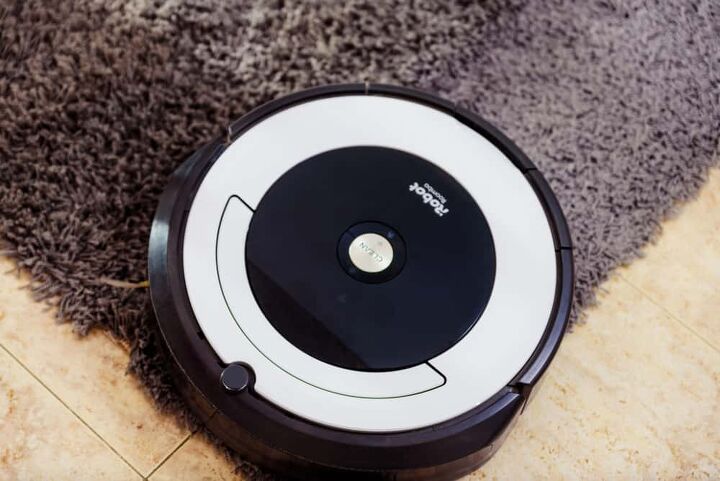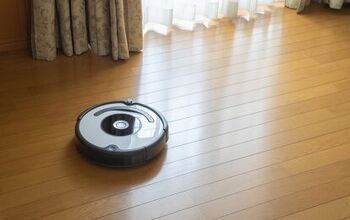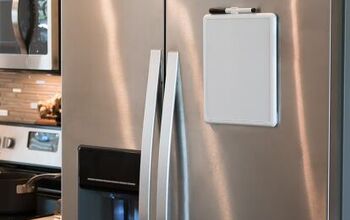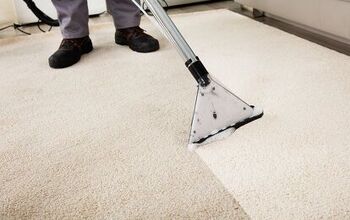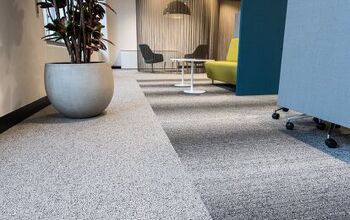Can A Roomba Be Used On Carpet? (Find Out Now!)

Roombas are the gold standard of vacuum robots that do all the work for you. They’re often seen buzzing around on tile, wood, and laminate floors. Of course, many people are beginning to wonder if their carpeted flooring could use a little visit from their favorite self-guided vacuum. So what should homeowners expect to see happen if they try to use a Roomba on their carpet?
Though Roombas once were unable to work well on carpeting, they are now wonderful for almost every type of carpet. If you have a modern Roomba model you will be able to use it on both hardwood and carpeting. You can thank the Roomba’s strong suction power for that versatility.
It’s understandable if you wanted to double-check what a Roomba is capable of before you buy one. If you’re curious about what this brand of robot vacuum can do, keep reading this article.
Do You Need a Maid Service?
Get free, zero-commitment quotes from pro contractors near you.

What Kind Of Surfaces Can Roombas Be Used On?
Roombas are remarkably versatile, and they get more features with every single upgrade and iteration. Because of their excellent suction power and sturdy build, you can expect Roombas to work on the following surfaces:
- Tile
- Hardwood
- Laminate
- Short Pile Carpet
- Deep Carpet
Can Roombas Be Used On Rugs?
This depends on the rug, but it is not advisable regardless of the rug type that you have. Roombas have a tendency of grabbing onto loose rug fibers or fringes, occasionally mauling them or causing the rug to fray. As a result, they are not advisable for rugs or carpets that have particularly long fibers.
Roombas can actually sustain permanent damage if they get snagged up in longer fibers. So keep them off that 70s sheepskin rug. It could be a little too risky, and truth be told, it probably should be cleaned by hand anyway.
Can Roombas Destroy Carpets And Rugs?
While long-fiber carpets and rugs can get seriously damaged as a result of an errant Roomba, it’s highly unlikely that your carpets and rugs will be destroyed by a Roomba. If you have a carpet made of delicate fibers, boasts exceptionally long threads, or is antique, it’s best to avoid using a Roomba on it.
A bigger issue that people find is that Roombas have a tendency of smearing items, only to keep moving. This has happened with dog poop, paint, and other materials. Your best bet is to keep a watchful eye on your Roomba while it works its magic.
What Are The Best Roombas For Carpet?
If you see a Roomba being sold on the market today, it’s safe to assume that you can use them on a carpet without much issue. However, some are still better than others. The most popular Roombas for carpet use include…
We actually have a full review of the Roomba 960 on our site, if you want to go into depth about this topic. However, what most people enjoy knowing is that this programmable Roomba has excellent carpet-friendly suction power, is compatible with Amazon Alexa, and also comes with world-class wi-fi connectivity.
This is one of the most upscale models on the market today, and it’s fairly pricey as a result. People who insist on having all the bells and whistles should strongly consider this one.
If you’ve kept up with Roomba reviews, you probably noticed that the i7 is considered to be the standard for people who want to keep their homes clean without too much effort. The i7 has spectacular room mapping and programming capabilities and also boasts smart home compatibility.
Though you can get even better results with the i7 Plus, most people prefer to get the i7. Why? Because this is more affordable yet still comes with a power suction feature that gives you 10 times typical robot vacuum suction. The end result is a Roomba that is excellent for pet hair removal. As a bonus, this Roomba model also has voice control, so you can tell it where to vacuum in realtime.
There was a time where buying a Roomba required shelling out a pretty penny. The Roomba 675, while an older model, still remains an excellent choice if you’re looking for a basic model that works well with carpeting. This particular model was designed with pet hair removal in mind. Thanks to its three-stage cleaning system, you don’t have to worry about subpar cleaning.
With that said, this self-charging robot vacuum doesn’t have the capacity that other iRobot products do. Even so, it still adapts its motors to the type of flooring it is on, so all is not lost.
It’s hard to imagine a robot vacuum that would be considered a status symbol, but this could definitely be one. The i9+ is the top of the line as far as iRobot products, and it shows. Along with all the features of a Roomba i7, you get to enjoy even more powerful suction, better floor mapping, and a fully functional anti-allergy system.
What really sets this apart from the others, though, is its automatic dirt disposal. So this Roomba doesn’t only go over to charge itself. It also takes out all the dust and dirt it collects on its own. All you need to do is take out the trash! It’s not cheap, but it’s one robotic cleaner that you can rely on.
What Kinds Of Carpets Don’t Fare Well With Roombas?
While most carpets will fare well with Roombas, there are certain types of carpets that just don’t mesh well with them. The most commonly-contraindicated include:
- Old Rugs And Carpets. Roombas can be harsh on carpets, and their rough bristles have been known to fray more delicate fibers. Some anecdotal evidence suggests that they can speed up the aging process that carpets undergo. Old rugs might be too brittle to handle it.
- Shag Rugs. We already went over why long-bristled rugs should not be paired with a Roomba. Shag rugs are the granddaddy of all long, shaggy rugs.
- Straw Rugs. The bristles of a Roomba will break down the brittle, easily broken parts of straw or woven rugs. Since straw can also clog filters, it can also damage your machine.
- High Pile Carpets. While they technically can be used on deep carpets, the truth is that there’s still a limit to how well they can work on high pile. If you were hoping for a deep clean, it’s best to invest in one of the latest models to hit the market. Otherwise, you may be disappointed.
- Carpeted Stairs. Though Roombas are fairly awesome, they do not work well on stairs. If anything, using it on stairs could end up causing your Roomba to break.
The Pros and Cons of Owning a Roomba
Even if a Roomba will work on your carpeting, you may still be on the fence about whether or not your home will benefit from one. To help you make your decision, consider the most well-known pros and cons of owning a Roomba.
Pros of Owning a Roomba
- They clean quickly. Immediately after turning your Roomba on, it’ll spring to life and head off to clean in any given direction.
- Their sensors tell them where borders are established. This means you won’t have to worry about your Roomba running aimlessly into your carpet or falling down the stairs. While this was a common issue when Roombas were first released, it isn’t anymore.
- They sense when an area isn’t fully cleaned. Roombas know when an area requires extra cleaning and they will double back over it several times to address these spots.
- Roombas can extend the life of your carpeting. Lingering dust and debris can slowly deteriorate your carpet and rugs. Since your Roomba takes care of all this unwanted debris, your carpet will end up lasting longer.
- You can set and leave a Roomba. Although the machine will need to be recharged from time to time, you can leave it running even when you leave your home. Then, come back a couple hours later and enjoy clean carpet!
Cons of Owning a Roomba
- Some claim the sensors to be finnicky. In some cases, a Roomba will skip over a carpet if it is dark enough for the machine to register it as a barrier or ledge. Though, you can bypass this issue by covering the sensor with tape, but this can cause the Roomba to fall down stairs if it gets too close.
- They aren’t designed to deep clean your carpets. If you spilled something on your carpet, you can’t rely on these devices to clean them up for you. Roombas are only designed to suck up surface-level debris, like crumbs, dust, hair, cat litter, and the like.
- Roombas cannot register clothes, cables, and low spots. These items are often too small for Roombas to sense. Things like clothing and cables will slow down and completely stop your Roomba if it comes across them.
Do You Need a Maid Service?
Get free, zero-commitment quotes from pro contractors near you.

Related Questions
What is the best Roomba model for families on a budget?
If you want to splurge on a Roomba but don’t have much money to splurge with, then the best option for your money is a Roomba 675. While this may not have all the features and upgrades that a later model may have, it still offers all the basic features homeowners would need in order to get your floors clean.
Since the Roomba 675 is fairly old, it’s also possible to get them certified refurbished. This can further increase your savings while still giving you the functionality you want.
How long do Roombas last?
While Roombas are popular and highly useful, they do not last long when compared to standard vacuums. If you get a Roomba, you can expect it to last two to five years. The biggest factor that you need to be aware of is its maintenance. Well-maintained Roombas will last closer to five years, while neglected ones may last as low as one.
People who are hoping for a major investment that’s durable will find that a Roomba isn’t right for them.
Will a Roomba fall down the stairs?
Nope. Modern Roomba models have cliff sensing that will prevent it from falling down the stairs. With that said, you also can’t expect them to climb down the stairs. That’s why it’s best to have at least one Roomba unit per floor.
Related Guide

Ossiana Tepfenhart is an expert writer, focusing on interior design and general home tips. Writing is her life, and it's what she does best. Her interests include art and real estate investments.
More by Ossiana Tepfenhart



